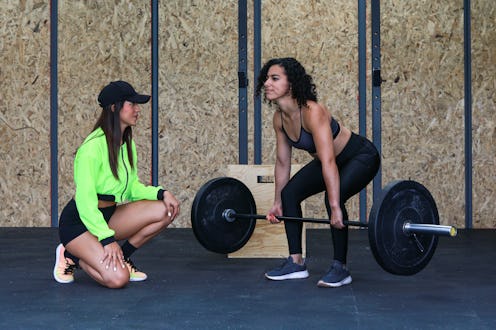Fitness
All The Muscles You Work When Doing Deadlifts
Don't sleep on this staple strength move.

The deadlift might seem like an intimidating move reserved for the more serious weightlifters at the gym. But once you realize how to do a deadlift — and all the muscles a deadlift works — it’ll quickly become something you’re excited to add to your workout routine.
To put it simply, a deadlift is a hip-hinging compound exercise, which means it works many parts of your body at once, says Brittany Geary, an ACE-certified personal trainer at Ladies Who Lift. Unlike an isolation exercise that works one muscle at a time, like a bicep curl, the deadlift gets a lot done in one fell swoop.
Do a round of deadlifts and you’ll effectively work your hamstrings, glutes, back, hips, core, and more, Geary tells Bustle. The hamstrings, aka the muscles down the backs of your legs, contract and lengthen as you lift and lower the weight. Your glutes light up as you press into the floor with your feet. And your back and core work together to keep your spine stable and maintain good lifting form.
Your hips also get a lot of attention when you do this exercise. “As a hip hinge dominant movement, you are 100% using your hips,” Geary says. “The hip flexors are being activated, allowing you to bend and extend your body.” By doing deadlifts on the reg, Geary says it can help reduce lower back pain, thanks to the way the movement strengthens your posterior chain. And, as an added bonus, deadlifts also work the grip muscles in your hands, since you grasp the barbell throughout each set. Read on for everything you need to know about the multi-beneficial deadlift exercise.
How To Do A Deadlift
Before you start, choose a weight that you can lift with relative ease throughout your assigned reps, but that starts to feel difficult right at the end. “You want to be sure that you are maintaining good form throughout and that it’s challenging, but not impossible,” Geary says. “Your first reps should not look like your last reps, and you should be pushing your muscles to their fullest potential.” Here, Geary breaks down how to do a classic deadlift with a barbell, though you could use dumbbells or a kettlebell instead.
- Stand with your feet hip-width apart.
- Walk up to the barbell and stop once the bar is lined up over your mid-foot.
- Hinge forward at the hips so that they’re lined up somewhere between your shoulders and knees.
- Keep a soft bend in your knees.
- Reach down to grab the bar or weights with an overhand grip. Your hands should be placed just outside your knees.
- Press your knees apart until they touch your forearms to create tension in your body.
- Engage your lats and lock your shoulders down and away from your ears.
- Take a big inhale through your nose to brace your core.
- Drive your lower body into the floor as you stand all the way up, dragging the barbell or weights with you.
- Keep your arms straight and the weights close to your body the whole time.
- Once upright, hinge forward at a 45-degree angle to lower the bar back to the ground.
- Maintain a neutral spine throughout the whole movement.
- Aim for 3 sets of 10 to 12 reps.
How To Modify A Deadlift
If you’re still learning or want to have a more relaxed day at the gym, you can make things easier by lifting just a barbell without weights attached so it isn’t too heavy. You can also add lifting straps to help with your grip, Geary says, or use a lifting belt to help brace your core. Alternatively, you could use light dumbbells.
To make the deadlift more challenging, Geary recommends adding weight, upping your reps, playing around with the tempo, or switching things up by performing a single-leg deadlift with dumbbells or a kettlebell. Whichever variation you try, just be sure to stay aware of your form, she says.
Common Deadlift Mistakes To Avoid
You might notice that it’s super tempting to round your shoulders as you lift, but try not to. “This puts you in an unsafe position where you use more of your upper body to lift the weight rather than using the lower body to push the weight away from the floor,” Geary says.
It’s also common for the knees and hips to wind up in the wrong spot. According to Geary, you don’t want your hips to push forward at the top of the motion, as that takes your spine out of a neutral position. Instead, it’s best to keep your ribs in line with your hip bones.
Because it’s a hip-hinging exercise, a deadlift shouldn’t see much knee action. While you should maintain a slight softness in the knees, most of your movement will happen in your hips. “Your shins should stay vertical and your knees should never be over the bar,” Geary notes. Keep this checklist in mind, and you should be set to real all the strength-boosting benefits of the move.
Studies referenced:
Berglund, L. (2015). Which Patients With Low Back Pain Benefit From Deadlift Training? J Strength Cond Res. doi: 10.1519/JSC.0000000000000837.
Martín-Fuentes, I. (2020). Electromyographic activity in deadlift exercise and its variants. A systematic review. PLoS One. doi: 10.1371/journal.pone.0229507.
Sources:
Brittany Geary, ACE-certified personal trainer at Ladies Who Lift
This article was originally published on